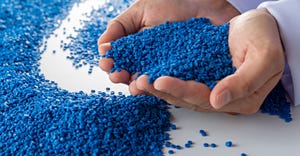Broadening the Customer Base
September 15, 1998
One of SMI's specialty products is this urethane ski goggle frame, which must be removed from the mold manually, and in a specific way so the frame will not distort when pulled from the mold core while still hot. |
How does a custom injection molder remake its image, one that's defined the company during its entire 16-year history? By remarketing itself, says Sports Molding Inc.'s new director of marketing and sales, Scott J. Smith. Smith, who began working for the Clearfield, UT molder in November of last year, says that although molding for the sporting goods industry has been the company's business since its 1981 beginning, new opportunities in this industry have slowed.
"We will continue to serve and enjoy the business relationships we share with our current customer base, never forgetting who got us to this point," says Smith. "However, we need to expand our marketing efforts and diversify into new industries."
Reasons to Change
There are several reasons for this, including the changing dynamics of the sporting goods industry and increased global competition. The company has its roots in molding ski goggles for two local companies. Since that time, growth for the company has been primarily by word of mouth. And some of that growth has come from industries outside sporting goods.
But with a name like Sports Molding, "other industries may view our capabilities as rather limited," says Smith. Changing the company's image to one that defines its capabilities in broader terms is a challenge.
The Sports Molding marketing team decided to highlight the company's initials, SMI, in order to downplay the "sports" part of the name. "SMI is our new logo, but we are still known by our current customers as Sports Molding, and to them we probably always will be," says Smith. "Now, all of our cards, letterhead, shipping cartons, and other related materials reflect our new logo, SMI."
Defining the Future
Smith, a marketing professional from California with a background in plastics manufacturing, also began a comprehensive marketing strategy that included defining what the company is vs. what it wants to be. He conducted interviews with the employees, and contracted with an outside market research firm to conduct a survey of the company's customer base. "One of the goals in this is to closely align ourselves with the wants and needs of customers in our current and new target market segments," says Smith.
This exercise gave the company a picture of its capabilities. One of the areas in which SMI has acquired an expertise is molding polyurethane. The urethane frame around ski goggles presents molding challenges that SMI has conquered through its years of experience. For example, the goggle frames must be removed from the mold by hand, and in a specific way so as not to distort the frame when pulled from the mold core while still hot (see photo).
The SMI marketing strategy includes seeking out new business in other industries that have similar requirements and materials to those of the company's current customers. "Using our past experience in molding small, complex parts and working with engineering thermoplastics, we can take on new clients in other industries and expand our business base," says Smith.
Problem Solving
Solving a customer's special molding and manufacturing problems is another of SMI's strengths. For example, a maker of bowling balls came to SMI with a unique dilemma. A bowling ball is made from urethane with a hollow core in which a heavier insert is put to give the ball weight and stability. The company had tried injection molding a solid core but could only achieve one that weighed less than a pound, which wasn't enough.
SMI took on the project and, working closely with resin supplier LNP, came up with a proprietary, filled material that had the same dimensions as the original core but weighed 3.1 lb. "The point is," emphasizes Smith, "we love to solve unique problems, to take on new projects that challenge us and stretch our capabilities into new and exciting areas."
Smith cautions however, that in diversifying from the sporting goods industry, SMI can't make the "big mistake" many molders make and "try to be all things to all people." That's why the SMI management team carefully reviews each new project brought to the company.
Some new projects SMI has acquired recently include masks for players engaging in the popular paint-ball game, and a window-blind company finds SMI's capabilities in molding small, tight-toleranced parts beneficial to making components from engineering thermoplastics that require long-term functionality and durability.
In keeping with its goals of expanding its business, SMI recently moved into a 62,000-sq-ft facility, giving it one-third more space, thus permitting better floor space utilization and room for future growth. SMI currently operates 35 molding machines, including a cell of 18 20-ton Arburgs for precision small-parts molding, many equipped with robots to reduce labor costs. Clamping forces range from 20 to 400 tons.
The company has full moldmaking capabilities, but also outsources to both domestic and off-shore moldmakers. SMI performs insert molding and secondary operations including hot stamping, light assembly, and heat transfer.
SMI's marketing team believes the remaking of SMI into a diverse supplier of engineered thermoplastic components for a variety of industries, while utilizing the experience of its sporting goods molding background, will be successful. "The industry doesn't matter," says Smith. "We're not industry specific, we're ability specific."
You May Also Like


